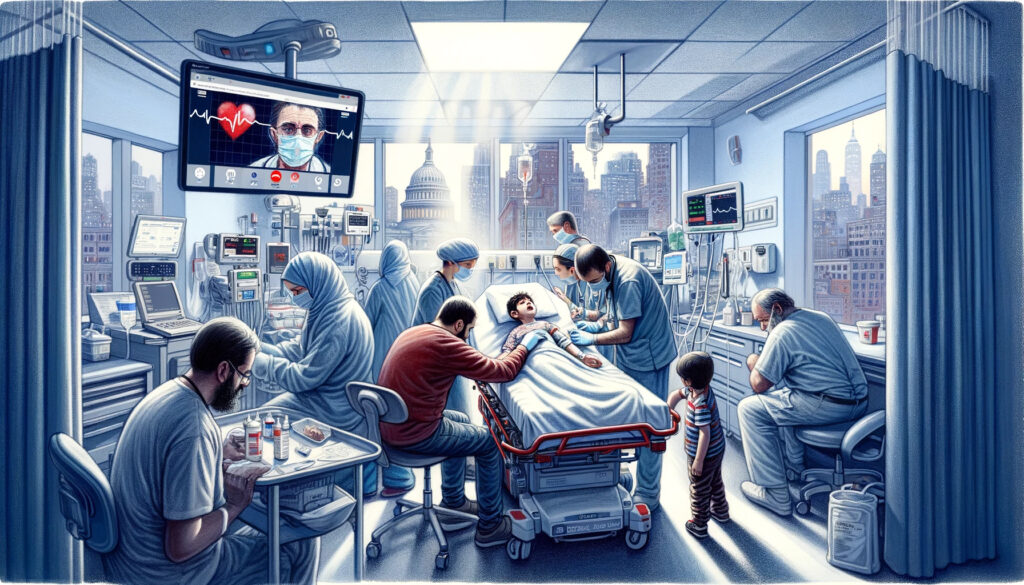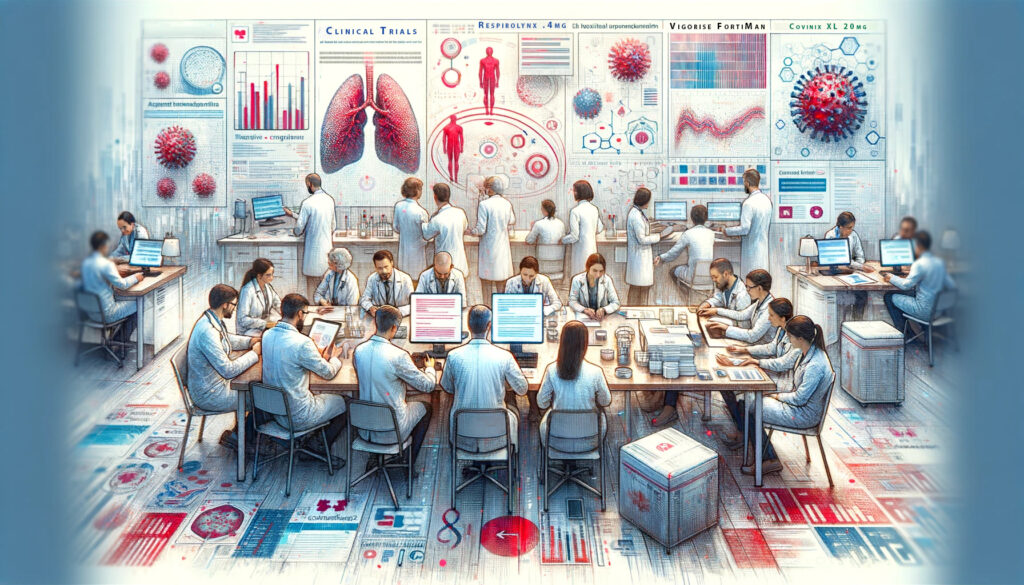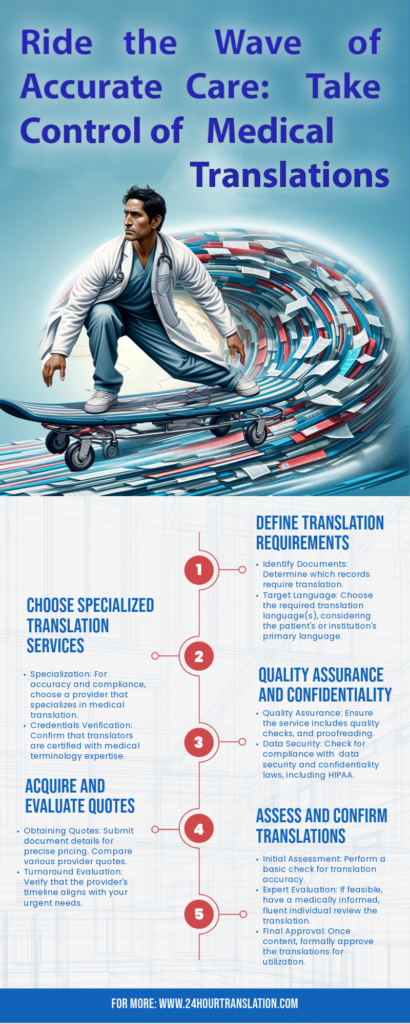Introduction to the Article
In today’s increasingly multilingual society, where approximately 21.9% of U.S. households speak a language other than English, the role of medical translation in patient safety and healthcare communication is becoming ever more critical. Have you considered the risks associated with misunderstanding medical information due to language barriers? This reality underscores the vital need for accurate and accessible medical translation.
In addressing this need, specialized services play a pivotal role in bridging the linguistic gaps in healthcare. But what makes accurate medical translation so essential in the realm of modern healthcare?
The Imperative of Accurate Medical Translation in Modern Healthcare
Imagine the potential consequences of medication errors or misdiagnoses among patients with Limited English Proficiency (LEP). The stakes are significant. Research from the Agency for Healthcare Research and Quality (AHRQ) highlights that providing translated materials in preferred languages can substantially reduce medical errors. This insight underscores the importance of precise translation in healthcare.
Ensuring patient safety through accurate and timely translations is a complex task, often involving intricate aspects such as compliance with legal and medical standards. This necessity for accuracy in medical translation isn’t just about linguistic proficiency; it’s about understanding the medical context and nuances, a topic explored in the guide on selecting the right medical translation service.
Maria’s Journey: Overcoming Language Barriers in Healthcare
A Heartfelt Story of Navigating the Medical System with Limited English Proficiency
Maria Gonzalez, a 58-year-old native Spanish speaker, moved to the United States five years ago. Despite her enthusiasm for a new life, she faced a daunting challenge that many immigrants encounter: limited English proficiency (LEP). This language barrier became particularly significant when Maria was diagnosed with type 2 diabetes.
The Challenge of Understanding Medical Information
Maria’s first few visits to the clinic were overwhelming. Medical terms, treatment plans, and medication instructions were all in English, a language she barely understood. This language gap led to confusion about her condition and how to manage it. She once admitted, “I felt lost and scared. I didn’t fully understand what diabetes meant for my health.”
The Turning Point: Professional Medical Translation
The turning point came when her healthcare provider started using professional medical translation services. Suddenly, Maria’s medical documents, including her diagnosis, treatment options, and medication guidelines, were available in Spanish.
Improved Patient Engagement and Safety
With translated materials, Maria could actively participate in her healthcare decisions. She understood the importance of diet control, medication adherence, and regular check-ups in managing diabetes. Her son, Carlos, noticed the change, saying, “Mom was more confident in managing her health. She even started teaching our family about diabetes.”
The Role of Medical Interpreters
During her appointments, the presence of a medical interpreter was transformative. Maria could communicate her symptoms and concerns effectively, and in return, receive clear explanations from her doctor. This not only improved her comprehension but also her satisfaction with the healthcare services.
The Impact on Healthcare Outcomes
As a result of effective communication, Maria’s health improved significantly. Her blood sugar levels stabilized, and her risk of diabetes-related complications decreased. Her story highlights the critical role of medical translation and interpretation in patient safety and healthcare outcomes.
Conclusion: A Call for Inclusive Healthcare Communication
Maria’s experience underscores the necessity for accessible and accurate medical translation in healthcare. It’s a call to action for healthcare providers to prioritize language services, ensuring that no patient is left behind due to language barriers.
Addressing Key Challenges in Medical Translation
Navigating the Cost Factor: Affordable and Transparent Medical Translation Services
One of the primary concerns in medical translation is the cost. How do we balance the need for high-quality translation with affordability? It’s essential to find a solution that offers transparent pricing without compromising on the accuracy and quality essential in medical contexts. Affordability shouldn’t mean a reduction in standards, especially when patient safety is at stake. Understanding the pricing structure and affordability of translation services is crucial in making an informed decision.
The Quest for Qualified Translators in Medical Settings
Another significant challenge is ensuring the use of certified medical translators. The stakes are too high for any compromise on qualifications and expertise. Qualified translators not only possess linguistic skills but also have an in-depth understanding of medical terminologies and practices. The importance of choosing specialized medical translation services cannot be overstated, as they bring a level of precision and expertise that general translation services may not offer.
Safeguarding Data: The Pillar of Security and Confidentiality in Medical Translation
In the field of medical translation, confidentiality and security of patient data are paramount. Adhering to HIPAA regulations and ensuring strict data security protocols is non-negotiable. How do translation services maintain the integrity and confidentiality of sensitive medical information? It’s essential to partner with services that prioritize data security and HIPAA compliance, ensuring that patient information remains protected at all times.
Case Study: Navigating a Pediatric Emergency Through Medical Translation
Bridging Communication Gaps in a Time-Critical Situation
In the pediatric ward of a bustling city hospital, a critical case unfolded that highlighted the indispensable role of medical translation. Eight-year-old Amir, a recent refugee from Syria, arrived at the emergency room with severe asthma symptoms. Accompanied only by his older brother, who spoke limited English, the situation was tense and fraught with communication challenges.
The Communication Barrier in a Pediatric Emergency
Amir’s brother, 15-year-old Malik, struggled to convey the severity of Amir’s condition and his medical history. The medical staff were unable to extract crucial information such as Amir’s medication allergies or previous asthma treatments. Every second was crucial, yet the language barrier created a dangerous gap in understanding.

The Role of Real-Time Medical Translation
Recognizing the urgency, the hospital staff quickly utilized their on-call medical translation service. A skilled translator, proficient in both English and Arabic, was immediately brought in through a video call. The translator facilitated real-time, accurate communication between Malik and the medical team.
Impact on Diagnosis and Treatment
With the translator’s assistance, the medical team learned that Amir had a history of severe asthma attacks and was allergic to certain asthma medications. This information was vital for administering the correct treatment swiftly. The translator also helped explain the treatment plan to Malik, ensuring he understood the steps being taken for Amir’s care.
Enhancing Patient Comfort and Trust
Amir, amidst his distress, found comfort in hearing his native language. It calmed him to know that his brother understood what was happening. This not only aided in his treatment but also built trust between the patient, his family, and the healthcare providers.
Outcome and Reflection
Thanks to the timely and accurate medical translation, Amir received appropriate care and recovered well. This case underscores the critical need for readily available medical translation services, especially in emergency scenarios. It highlights how overcoming language barriers can be crucial in healthcare. For residents in Houston, having access to reliable and proficient medical translation services is imperative. The article, 4 Top Medical Translation Services in Houston: Save Time, Cut Costs, and Reduce Stress provides valuable insights into some of the best services available in the city. These services ensure that language barriers do not hinder the quality of healthcare, similar to what was crucial in Amir’s case.
Timeliness: The Essence of Urgency in Medical Translation Services
In medical emergencies and routine care, the need for quick and efficient translation is critical. How do translation services meet the demand for urgent translations without sacrificing accuracy? The ability to provide prompt services, particularly in emergency situations, is a crucial aspect of medical translation. Discovering solutions that offer 24/7 availability and fast turnaround times is vital in ensuring that language barriers do not impede timely and effective patient care.
The Impact of Medical Translation on Patient Care and Legal Compliance
The Role of Medical Translation in Patient Decision-Making and Engagement
Accurate and accessible medical translation plays a pivotal role in empowering patients with Limited English Proficiency (LEP). Studies indicate that LEP patients are more involved in their healthcare decisions when information is accurately translated. How can we ensure that all patients, regardless of their language proficiency, have the opportunity to make informed decisions about their health? Integrating culturally competent and linguistically appropriate services is crucial in promoting patient engagement and effective decision-making.
Communication Clarity Leading to Enhanced Treatment Adherence
Clear and accurate medical communication is instrumental in boosting treatment adherence. When patients fully understand their diagnoses and treatment plans, their adherence to these plans improves, leading to better health outcomes. This underscores the importance of providing accurate medical translations to ensure clear communication between healthcare providers and patients.
The Legal Mandate: Providing Language Access Services to LEP Patients
Healthcare institutions have a legal obligation to provide language access services to LEP patients. This requirement stems from federal and state laws that prohibit national origin discrimination. How do healthcare providers ensure compliance with these legal mandates? It involves partnering with translation services that are well-versed in the legalities of medical translation, ensuring that every patient receives the care they deserve, in a language they understand.
Addressing the Language Gap in American Healthcare
With a substantial portion of the U.S. population speaking languages other than English at home, the need for medical translation is more pressing than ever. Bridging this language gap is essential for effective healthcare delivery. How do we tackle this growing need for translation in a multilingual society? The answer lies in enhancing the diversity and equity in clinical trials and healthcare communication, ensuring that no patient is left behind due to language barriers.
The High Stakes of Miscommunication: Risks for LEP Patients in Healthcare
The risks associated with miscommunication in healthcare are particularly high for LEP patients. Studies show that these patients are 2-3 times more likely to experience adverse events due to communication problems. How can we mitigate these risks? Ensuring accurate and culturally sensitive medical translations is a key step in reducing the likelihood of such adverse events and improving patient safety.
Enhancing Healthcare Through Professional Medical Translation
The Efficacy of Professional Medical Interpreters in Patient Comprehension and Satisfaction
The use of professional medical interpreters has been linked to improved patient comprehension and satisfaction. But how impactful are these services in real-life healthcare scenarios? A study in the Journal of General Internal Medicine found that professional interpreters were associated with a 20% reduction in 30-day readmission rates for LEP patients. This highlights the critical role of professional interpreters in enhancing patient outcomes and satisfaction. What experiences have you had with medical interpretation services, and how have they influenced your healthcare journey?

Medical Translation in Clinical Trials and Research
In the realm of clinical trials and medical research, the accuracy of translation is not just a convenience but a necessity. How does precise translation affect global patient involvement and data collection? Ensuring that complex medical terminologies are accurately translated is vital for the integrity of clinical trials. The role of specialized knowledge in this field cannot be understated, as it directly impacts the success and reliability of the research. Learn more about the challenges and importance of medical translation in clinical trials.
Your Health, Our Words: How Medical Translation Services Enhance Patient Safety and Care
The relationship between a patient’s health and the accuracy of medical translation is direct and profound. How do translation services like those offering comprehensive medical document translation contribute to patient safety and care? By ensuring that every piece of medical information is accurately conveyed, these services play an indispensable role in the healthcare process. What impact can personalized medical translation services have on your healthcare experience?
The Call to Action: Take the Next Step with Medical Translation Services
Now that we’ve explored the crucial importance of medical translation in healthcare, what’s the next step? For anyone in need of medical translation services, whether for personal or professional reasons, the time to act is now. With options available that offer ease of access, professional service quality, and a commitment to patient safety, taking this step could be transformative for your healthcare needs. Ready to explore more about these services or get in touch with a professional provider? Consider reaching out to services that specialize in medical and pharmaceutical translations for your specific needs.
Conclusion: Bridging Language Barriers for Better Healthcare Outcomes
In summary, the importance of medical translation in today’s multilingual society cannot be overstated. From ensuring patient safety to facilitating informed decision-making, medical translation plays a pivotal role in the healthcare sector. It not only addresses the language gap but also upholds legal compliance and enhances patient engagement. Reflecting on these aspects, how will you integrate medical translation into your healthcare practices, whether personally or professionally, to bridge language barriers and improve healthcare outcomes?
FAQs
Comprehensive medical translation services cover a wide range of documents, including clinical trials, patient records, medical research papers, and consent forms. Each type of document demands a specific approach to ensure accuracy and contextual relevance.
Professional translation services maintain accuracy through certified translators, rigorous vetting processes, and multiple quality checks. Confidentiality is upheld by adhering to HIPAA compliance and employing the latest encryption technologies for data security.
Specialized medical translation services cover a broad spectrum of languages, from widely spoken languages like Spanish and French to less commonly spoken languages, ensuring inclusivity and accessibility for diverse patient populations.
Many translation services offer expedited options, including 24-hour turnaround times for critical situations. This rapid response is crucial in emergency medical scenarios, where timely translation can significantly impact patient care.
Specialized medical translation services distinguish themselves with their deep understanding of medical terminology, commitment to accuracy, cultural sensitivity, and adherence to legal and ethical standards. Their expertise in the medical field ensures that translations are not just linguistically correct but also contextually appropriate.


